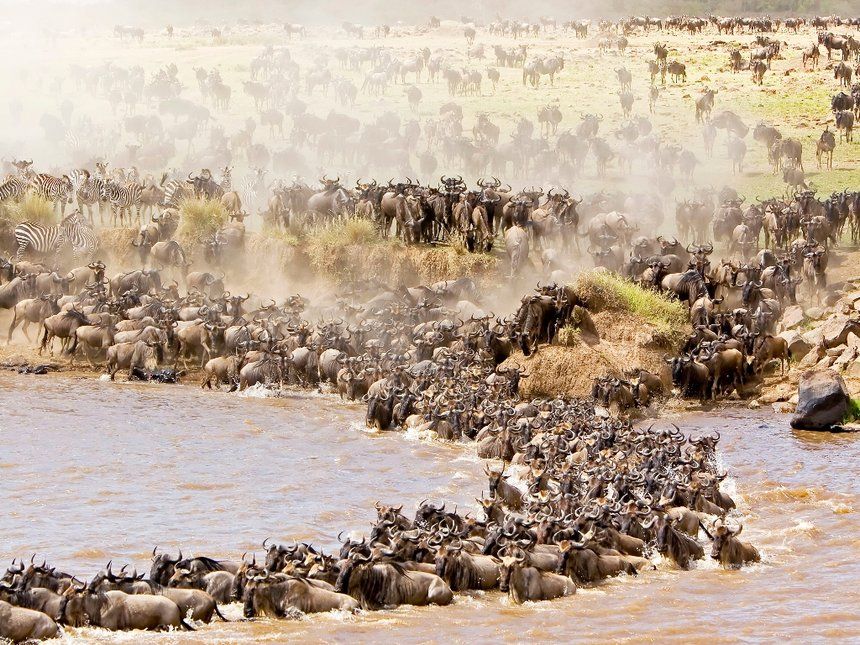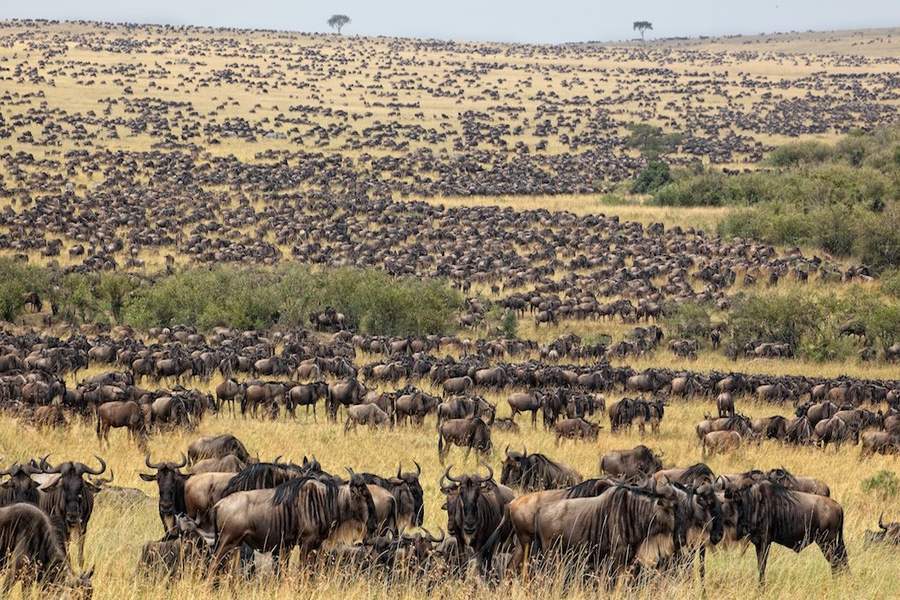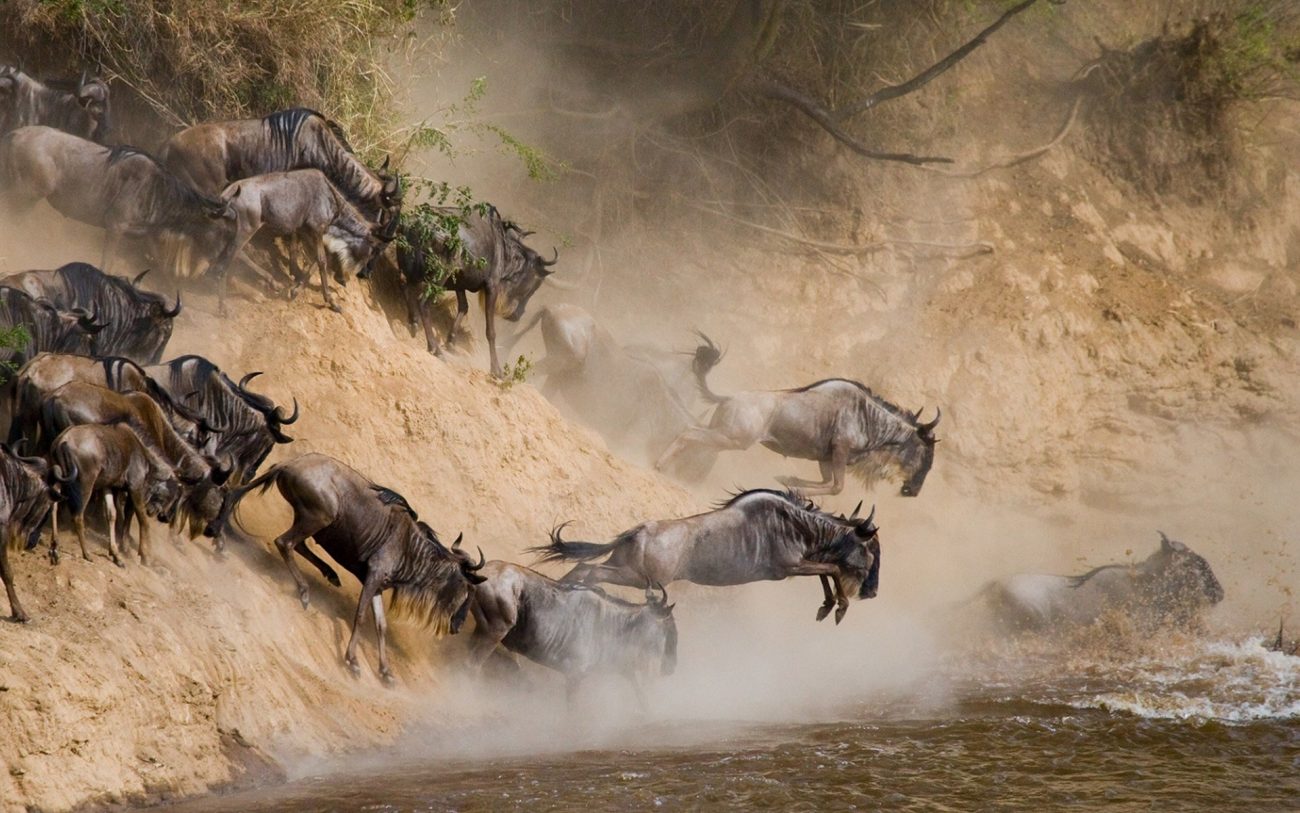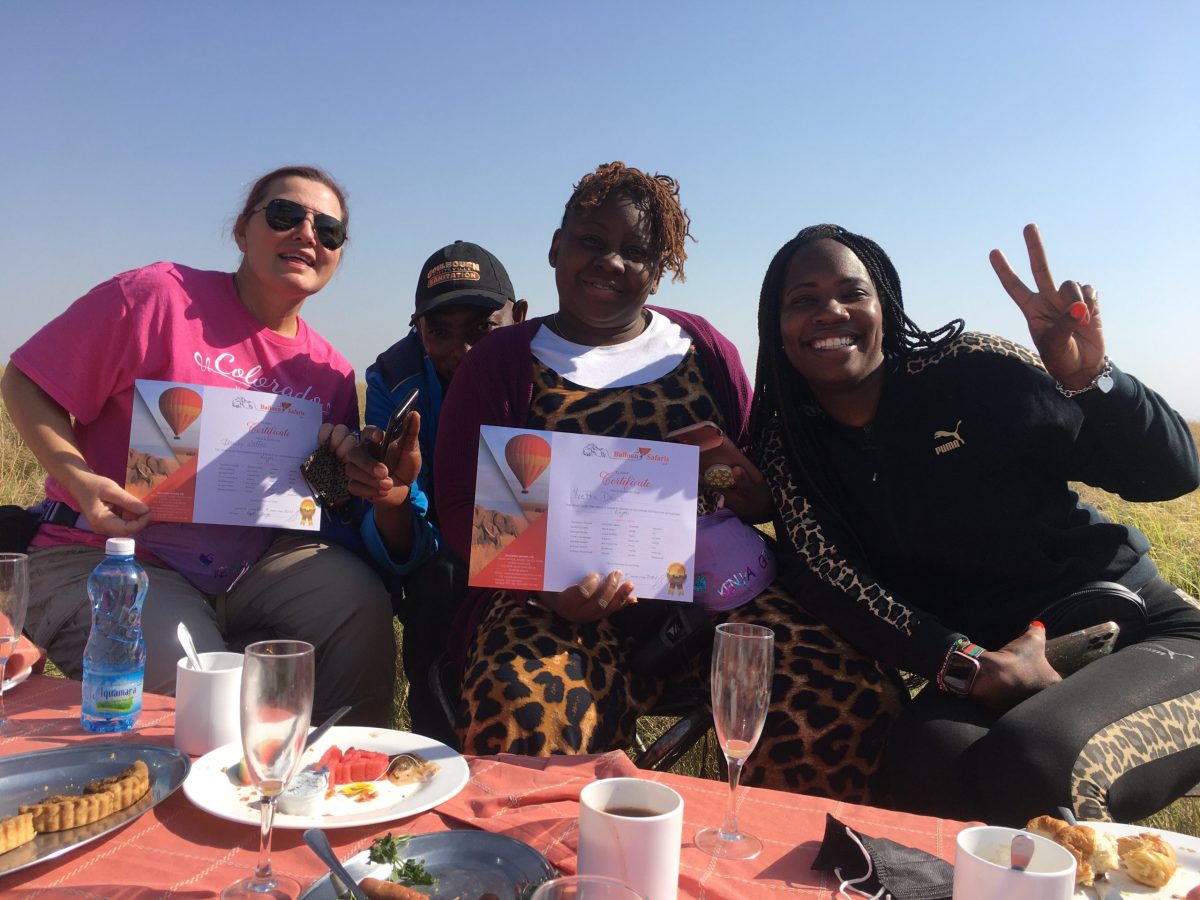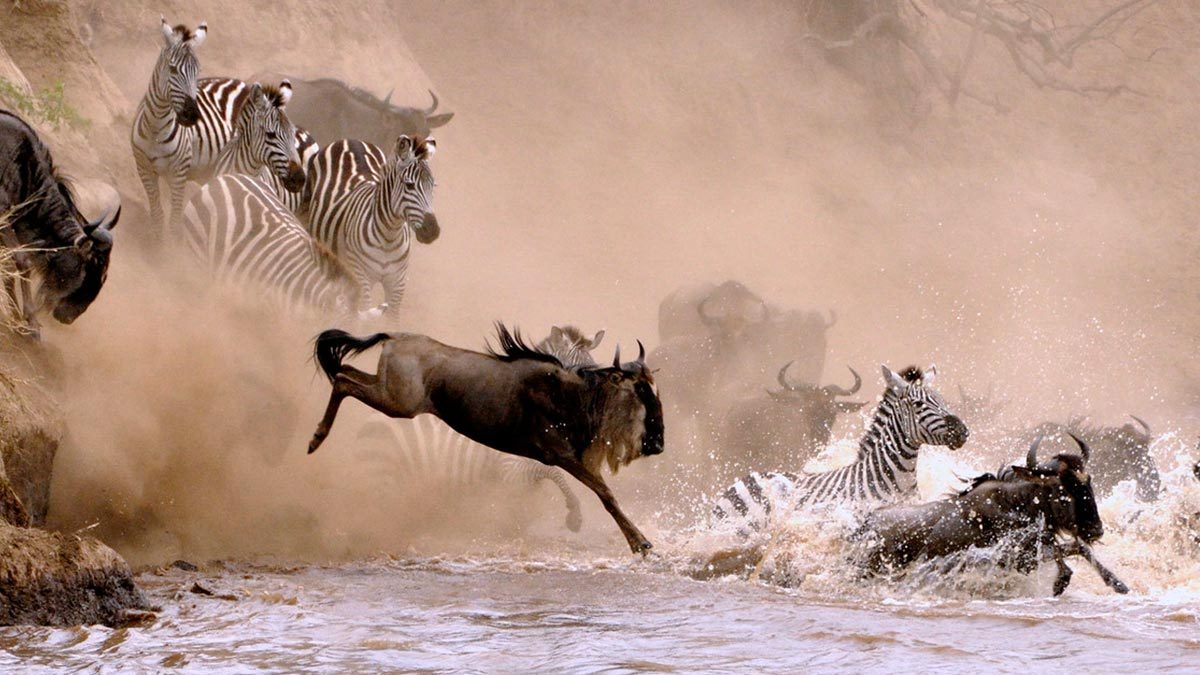Great Wildebeest Migration Photo Safari in Kenya and Tanzania
The Great Wildebeest Migration Photo Safari stands as one of nature’s most awe-inspiring spectacles. Over 1.5 million wildebeest, accompanied by hundreds of thousands of zebras and gazelles, traverse an ancient circular route across Tanzania’s Serengeti National Park and Kenya’s Masai Mara ecosystem in search of water and nutritious grazing. This continuous journey, dictated by survival instincts and the rhythm of the rains, presents unmatched photographic opportunities for wildlife enthusiasts. The immense herds are so large that they can be observed from space, providing an iconic view of one of Africa’s most celebrated natural events. Each stage of the migration offers unique experiences, predator-prey interactions, and cultural encounters, making it an unforgettable adventure for photographers, safari-goers, and nature lovers alike.
Detailed Great Wildlife Migration Photo Safari
Southern Serengeti: The Calving Season Experience
The Great Migration Photo Safari begins in the southern Serengeti, where wildebeest give birth to their calves in sync with the arrival of seasonal rains. By late January and February, approximately 400,000 calves are born within a short period, creating nearly 8,000 new arrivals each day. This stage, famously known as the Calving Season, is a photographer’s paradise. The open short-grass plains of southern Serengeti provide unobstructed views, allowing visitors to capture vivid images of newborn calves, attentive mothers, and dramatic predator-prey interactions.
The concentration of vulnerable young attracts numerous predators, including lions, cheetahs, leopards, and hyenas, creating a living tableau of the “Circle of Life.” This period presents extraordinary opportunities for Great Migration Photography Safaris as wildlife photographers can witness intense action, from lion hunts to cheetahs sprinting after unsuspecting calves. The contrast of the golden grasses against the blue African skies enhances visual storytelling, while the sheer density of the migrating herds conveys the magnitude of this natural phenomenon.
In addition to wildlife photography, cultural experiences abound in nearby villages. Local Maasai communities offer authentic encounters, where visitors can witness traditional ceremonies, beadwork craftsmanship, and pastoralist practices. Photographers and travelers can combine these cultural moments with wildlife imagery, adding depth and storytelling value to their safari portfolio. Safari lodges in the southern Serengeti provide luxury and comfort while placing guests at the heart of this migratory spectacle, making it the ideal starting point for any Great Migration Photo Safari.
Tracking the Migration: Wildebeest Movements Through Southern Plains
Following the Calving Season, the herds gradually begin to disperse across the southern Serengeti plains. By March and April, adult wildebeest and their young start traveling toward nutrient-rich grazing grounds, guided by instinct and the promise of fresh grass nourished by seasonal rains. Each individual wildebeest can travel between 800 and 1,000 kilometers during the migration, navigating ancient routes passed down for generations. Photographers can capture both the intimate details of family groups and the grandeur of vast herds moving across endless plains.
The southern Serengeti is dotted with watering holes and temporary rivers, creating dynamic landscapes for photography. Migrating herds often interact with resident predators, and these encounters produce dramatic wildlife imagery, ideal for professional portfolios or personal collections. Safari lodges positioned along migration corridors provide unparalleled access for early-morning and late-afternoon photography, taking advantage of the golden hour light that illuminates the landscape.
During this period, cultural immersion remains a highlight. Visitors can meet Maasai warriors performing traditional dances or explore local markets, providing contextual storytelling elements that complement wildlife photography. Combining wildlife and cultural experiences at this stage enhances the depth of the Great Migration Photo Safari, showcasing both the ecological and human dimensions of this extraordinary phenomenon.
Western Serengeti: Crossing the Grumeti River
By late May, the wildebeest have mated, and the herds converge along the western corridor of the Serengeti, approaching the mighty Grumeti River. This crossing marks the beginning of a dramatic phase of the migration. The Grumeti River, teeming with crocodiles, tests the resilience and survival instincts of the herds. For photographers, capturing the tension, struggle, and triumph of these crossings offers unparalleled storytelling potential. Action shots of wildebeest leaping across the river, pursued by lurking Nile crocodiles, embody the essence of the Great Migration Photo Safari.
Predators exploit these crossings. Crocodiles launch ambushes from the river, while lions and hyenas patrol riverbanks for vulnerable prey. Photographers can capture rare images of predator-prey interactions at the water’s edge, making this one of the most thrilling segments of a Serengeti Great Migration Photo Safari. The combination of movement, wildlife behavior, and dramatic light conditions during early mornings and late afternoons enhances photographic outcomes.
Local cultural interactions enrich this stage of the journey. Maasai settlements along the western corridor allow guests to learn about traditional livestock herding, medicinal practices, and community life. Integrating these cultural moments with wildlife photography strengthens storytelling, providing a multidimensional perspective of life in the Serengeti ecosystem. Lodges in this area are strategically located for optimal access to Grumeti River crossings and surrounding photographic opportunities, allowing safari-goers to capture every nuance of this extraordinary migration event.
Kenya’s Masai Mara: The Mara River Crossings
The migration reaches its next dramatic chapter as the herds move north into Kenya’s Masai Mara ecosystem. Here, the Mara River separates the Mara Triangle from the Masai Mara National Reserve. The river crossings are iconic highlights of any Kenya Great Migration Photo Safari. Migrating wildebeest, zebras, and gazelles face powerful currents and stealthy Nile crocodiles while predators like lions and leopards lie in wait on the banks. These crossings epitomize the danger and beauty of Africa’s wildlife, providing some of the most iconic images in nature photography.
Depending on rainfall patterns, herds may cross the Mara River multiple times, creating repeated photographic opportunities. The crossings demand patience, timing, and understanding of animal behavior, making them ideal for serious wildlife photographers. The juxtaposition of powerful predators, vulnerable prey, and dynamic river environments generates images with dramatic tension and visual impact.
Beyond predator-prey interactions, the Masai Mara offers cultural experiences. Visitors can engage with Maasai communities, witness traditional beadwork, observe cattle grazing practices, or even join local ceremonies. Safari lodges provide comfortable vantage points overlooking the river and surrounding plains, ensuring guests can photograph these awe-inspiring events in safety and comfort. This combination of natural spectacle and cultural immersion positions the Mara River crossings as a must-see event for any Great Migration Photo Safari enthusiast.
Predator-Focused Photography in the Masai Mara
While the Mara River crossings are central to the migration narrative, the surrounding plains offer continuous action. Lions, leopards, cheetahs, hyenas, and even hippos provide additional subjects for wildlife photography. The Masai Mara’s predator dynamics differ from Tanzania, as resident predators contend with local herds in addition to migratory species. This interaction offers unique photographic opportunities, capturing rare behaviors such as lion prides hunting hippos or leopards stalking antelope.
During this stage, photographers can participate in specialized tours, including the Life of Predators Photo Tour, focused entirely on documenting carnivore behavior. The Masai Mara’s dramatic landscapes enhance these encounters, with golden sunsets, rolling hills, and acacia trees providing natural framing for images. Cluster keywords like “Masai Mara Photo Safari” and “Kenya Great Migration Photo Safari” can be integrated into captions, blog posts, and social media content to optimize exposure.
Cultural experiences remain integral. Maasai communities nearby offer insights into the relationship between humans and wildlife, particularly the traditional coexistence strategies employed to protect livestock while respecting predator territories. Visitors can photograph cultural practices alongside wildlife action, creating a compelling visual narrative that combines both ecological and anthropological dimensions.
October to November: The End of the Kenya Migration Season
By October, the majority of the migratory herds begin their return southward to the Serengeti, signaling the close of the Kenya migration season. While river crossings decrease, predator and prey activity in the Mara continues. Photographers benefit from lush post-rain landscapes, dramatic skies, and dynamic lighting conditions that enhance image composition. The combination of green vegetation and active wildlife provides visually compelling photography opportunities for both professionals and enthusiasts.
During this transition period, Great Migration Photo Safari-goers can also explore other wildlife species, including elephants, giraffes, topis, elands, and zebras, creating diverse portfolios beyond the primary migratory subjects. The short rains introduce vibrant colors to the Mara landscapes, offering a unique perspective compared to the drier winter months. Cultural engagements continue, with opportunities to document Maasai traditions, ceremonies, and daily village life.
Lodges remain operational throughout this period, providing strategic locations for photographing remaining wildlife action and scenic landscapes. Specialized tours such as the Women’s Only Mara Photo Tour combine cultural immersion with wildlife photography, creating memorable and meaningful experiences for travelers seeking both adventure and connection.
Returning to Southern Serengeti: The Cycle Continues
As November and December approach, the migratory herds complete their circuit, returning to the southern Serengeti in anticipation of the next calving season. This stage marks the continuation of the natural cycle, with predators adjusting their hunting strategies and prey preparing for the upcoming births. Photographers can capture the lush green landscapes, dramatic weather patterns, and interactions among resident wildlife during this period.
The Serengeti’s scenery transforms with the return of the short rains, offering photographers vivid backdrops of emerald grasses, flowering acacia trees, and misty mornings. Newborn antelope and other resident species provide additional subjects, complementing images of returning wildebeest and zebra herds. Safari lodges strategically placed in the southern Serengeti allow easy access to key wildlife corridors, ensuring photographers can document the natural rhythms of the ecosystem.
Cultural experiences at this stage include participation in traditional Maasai activities, learning about community rituals tied to seasonal changes, and observing livestock management techniques. By combining ecological, photographic, and cultural elements, Deks Safaris & Tours ensures that every Great Migration Photo Safari provides an immersive and authoritative experience, highlighting the intricate interplay between wildlife and human communities in East Africa.
Photography Tips and Strategies for the Great Migration
Capturing the Great Migration requires planning, patience, and technical expertise. Early morning and late afternoon light offer the best conditions for wildlife photography, creating warm, directional lighting that enhances textures and colors. Telephoto lenses are essential for photographing predators and river crossings, while wide-angle lenses help convey the scale and majesty of the migrating herds.
Photographers should remain flexible, as wildlife behavior is unpredictable, and opportunities can arise at any moment. Combining action shots of predator-prey encounters with environmental portraits of herds and cultural scenes creates compelling narratives.
Local guides provide invaluable insights into animal behavior, best photographic vantage points, and cultural protocols. By leveraging their expertise, safari-goers can maximize their chances of capturing once-in-a-lifetime images, whether documenting wildebeest crossings, lion hunts, or Maasai ceremonies. Every Great Migration Photo Safari by Deks Safaris & Tours combines technical guidance, storytelling, and luxury travel to deliver exceptional wildlife photography experiences.
Cultural Experiences Around Safari Lodges
Every stage of the Great Migration is enriched by cultural interactions with local communities. Maasai villages, located near key migration corridors, offer immersive experiences that complement wildlife photography. Visitors can participate in traditional dances, learn beadwork techniques, and explore pastoralist practices that have endured for generations. These encounters provide depth to the Great Migration Photo Safari narrative, allowing photographers to include human stories alongside wildlife action.
Lodges surrounding the Serengeti and Masai Mara are designed to integrate seamlessly with natural landscapes and cultural experiences. Guests can enjoy guided village visits, storytelling sessions with elders, and hands-on cultural workshops. By combining photographic opportunities with cultural immersion, Deks Safaris & Tours ensures that every Great Migration Photo Safari captures the full spectrum of East African life, from predator dynamics to pastoral traditions.
Planning Your Great Migration Photo Tour
Booking a Great Migration Photo Safari with Deks Safaris & Tours guarantees a comprehensive, expertly guided experience. The tours are scheduled to align with the migration’s chronological stages, from Southern Serengeti calving to Mara River crossings, and back. Each tour includes professional guidance, photography tips, comfortable lodging, and curated cultural experiences.
Whether you are a professional photographer or a passionate wildlife enthusiast, these tours provide unparalleled opportunities to document one of the world’s most remarkable natural phenomena. The integration of predator-focused excursions, vibrant landscapes, and Maasai cultural encounters ensures that every participant gains unique perspectives and creates a compelling visual narrative of the Great Wildebeest Migration.
Witnessing The Greatest Show on Earth
The Great Wildebeest Migration photo safari represents the pinnacle of Africa’s wildlife experiences. By following the migration chronologically from Southern Serengeti to Masai Mara and back, Deks Safaris & Tours provides unmatched access to natural spectacles, predator-prey interactions, and cultural richness. Each stage offers distinct photographic and storytelling opportunities, creating a comprehensive experience for travelers worldwide.
From the Calving Season in the Serengeti to the iconic Mara River crossings, and the lush return to Southern Serengeti, this continuous journey embodies the resilience, drama, and beauty of Africa’s wilderness. Combining wildlife, landscapes, and cultural interactions, a Great Migration Photo Safari by Deks Safaris & Tours delivers immersive, authoritative, and unforgettable adventures.
Embark on this extraordinary journey to capture, witness, and celebrate the raw power and majesty of the natural world, and elevate your photography and safari experiences to new heights.
Exceptional East Africa Gorilla Trekking & Wildlife Safari Holidays
- Uganda Primate Fly-In Safari 6-Day Experience
- 8-Day Uganda Big Five Safari Experience
- 9-Day Uganda Wildlife Safari Tour
- Kenya Uganda Rwanda 10-Day Tour
- 10-Day Uganda Safari Experience
- Kenya, Uganda, & Rwanda 12-Day Safari
- 14-day-all-inclusive-rwanda-wildlife-safari
- Kenya Tanzania Uganda 15-Day Safari
- 15-Day Uganda Wildlife & Primate habituation safari
- 6-Day Uganda Habituation Safari

